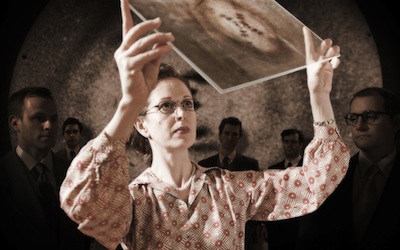By Charlene Kahn , JTNews Correspondent
Up alongside the process of major scientific research and discovery is the necessity of human communication. Within that context comes miscommunication. This scenario is the subject of “Photograph 51,” opening February 1 at Seattle Repertory Theatre on the Seattle Center Campus.
Written by Anna Ziegler, the play is directed by Braden Abraham, a native Northwesterner who’s been at The Rep for nine years, most recently as associate artistic director.
Early genetic research in post-war Britain brought fame to scientists like James Watson, Maurice Wilkins, and Francis Crick. Additionally, Rosalind Franklin was involved in leading research in several areas of scientific importance, including the identification and discovery of the structure of DNA.
Yet in 1962, Watson, Wilkens, and Crick shared the honor of a Nobel Prize, while Franklin’s contribution went unmentioned, her role dismissed and downgraded by Watson in his account of the discovery of the double helix.
Rosalind Elsie Franklin’s contribution to the discovery of DNA, with the use of an X-ray diffraction image of DNA nicknamed Photograph 51, is only recently becoming part of history. Fellowships, awards, and even a university have been named after her, and books have been penned about the physicist who died in 1958, at 37, of ovarian cancer.
The play focuses on the young British Jewish woman from Notting Hill, London. Born into a family long involved in Jewish causes, Franklin’s uncle was Sir Herbert Samuel, High Commissioner of Palestine during the British Mandate. Early on, Franklin showed a talent for chemistry and physics and stubbornly stayed true to her love of science, receiving her Ph.D. from Cambridge University. Her research extended far into natural and what later became genetic science.
Playwright Ziegler discovered Franklin and her story when researching another play. “I had never heard of her, but later [developed] a “˜love affair,’” she said. Ziegler worked on a project commissioned for the state of Maryland about three women in science. “It was a total education,” she said. “I even learned about the race [to discover the structure of DNA]. It was fun to write a play that’s an education for yourself.”
“Drawing from real accounts and her own imagination, Anna presents a fictionalized version of the race to claim this enormous discovery in very human terms,” said Abraham.” This is a play about the rewards and sacrifices of achieving great things.”
Franklin was “complicated, a prickly person, and was hard to work with,” said Ziegler. The role of Franklin will be played by Boston University grad Kirsten Potter.
“The portrait you see is [that] she’s a strong, directed person…but how circumstances get in her way” said Abraham. Franklin “was an outsider at King’s College,” and the play shows “how she feels, how she is being treated — she protects herself.”
“This is where the plays starts,” said Ziegler, “with a central miscommunication: [Franklin] thinks she is in charge.”
Staged in the smaller Leo K Theatre at Seattle Rep, all six characters remain on stage the entire time. Abraham says his production will be fluid, combining “narrative, real scenes and commentary.”
Asked if or how Seattle’s reputation as a biotech and science hub was a factor in staging the play here, Abraham said that the theatre “has added performances [because] Rosalind Franklin is pretty famous in the biotech community.”
This is Ziegler’s second time in the Northwest: In 2007, the Icicle Creek Theatre Festival in Leavenworth presented “Dov and Ali.” Ziegler likes the art scene at Seattle Center and finds Seattle “friendly, welcome and supportive,” she said. “It’s not true everywhere.”
“Photograph 51″ has already played to audiences in Los Angeles, New York, Washington, D.C., and Minneapolis. It has garnered awards from the Tribeca Film Institute Sloan Filmmaker Fund and STAGE International Competition. A film version starring Rachel Weisz is in the works.
“Photograph 51″ has “a sense of humor, and it’s funny, not dry,” said Ziegler. “There’s real warmth. It’s definitely not a play written by a scientist.”
